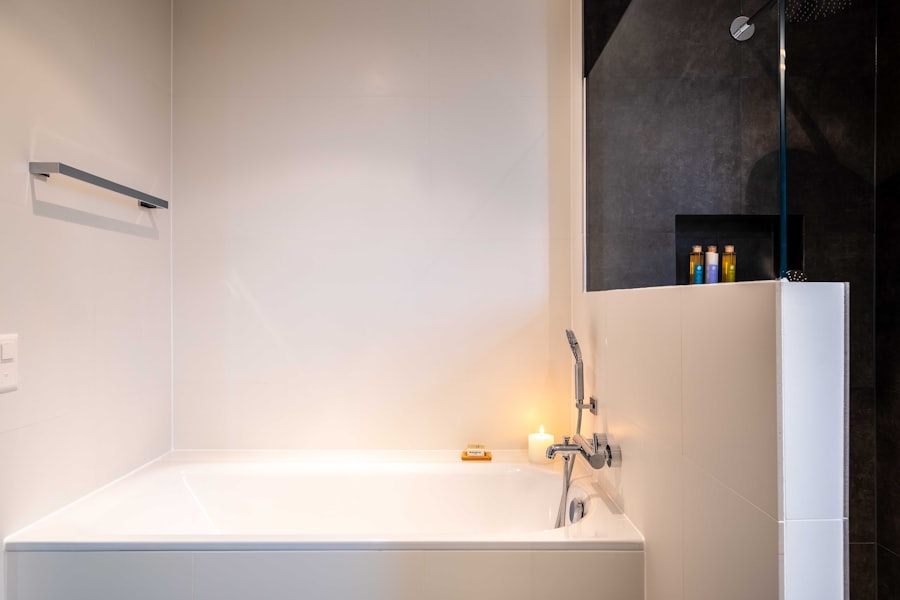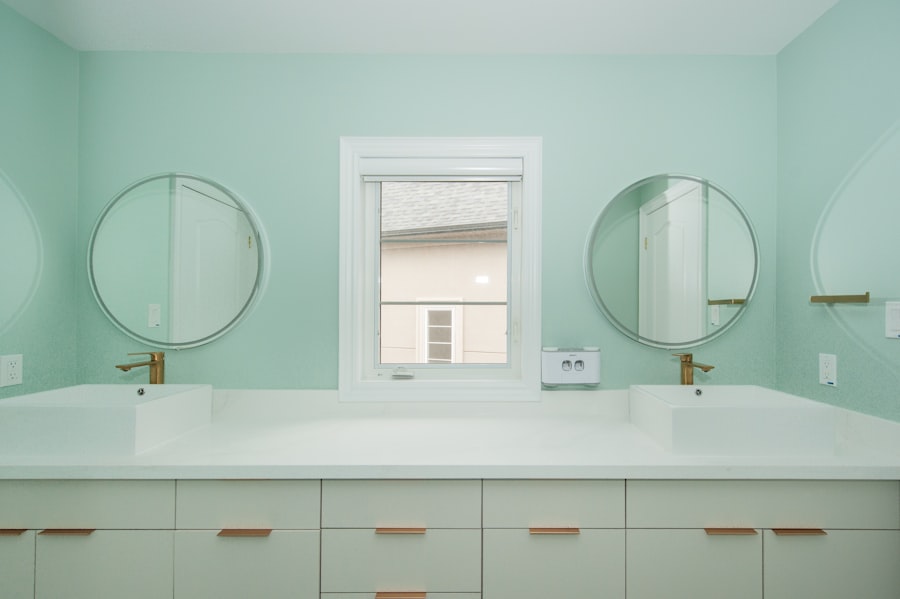When embarking on a bathroom remodeling project, the first step is to clearly define the scope of the work. This involves determining what aspects of the bathroom will be renovated, whether it’s a complete overhaul or just a few updates. A comprehensive understanding of the project scope helps in setting realistic expectations and timelines.
For instance, if the goal is to modernize an outdated bathroom, one might consider replacing fixtures, updating tiles, and enhancing lighting. Conversely, a more extensive remodel could involve reconfiguring the layout, which may include moving plumbing and electrical systems. Additionally, understanding the scope means recognizing the limitations and challenges that may arise during the remodeling process.
For example, older homes may have structural issues or outdated plumbing that could complicate renovations. It’s essential to assess the current state of the bathroom thoroughly before making decisions. This assessment can include checking for water damage, mold, or outdated electrical systems that may need to be addressed.
By having a clear picture of what needs to be done, homeowners can avoid unexpected surprises that could derail their project.
Key Takeaways
- Clearly define the project scope to avoid unexpected expenses.
- Establish a realistic budget based on materials and labor costs.
- Consider factors like plumbing, fixtures, and permits that impact overall cost.
- Select quality materials that balance durability and budget.
- Hire a reputable contractor to ensure professional workmanship and avoid hidden costs.
Setting a Realistic Budget
Establishing a budget is a critical component of any remodeling project, particularly in a space as complex as a bathroom. A realistic budget should encompass all aspects of the renovation, including materials, labor, permits, and any unforeseen expenses that may arise. Homeowners should begin by researching average costs for bathroom remodels in their area to gain a baseline understanding of what to expect.
For instance, a mid-range bathroom remodel can typically range from $10,000 to $25,000, depending on the extent of the work and the quality of materials chosen. Moreover, it’s important to allocate funds for contingencies. A common rule of thumb is to set aside an additional 10-20% of the total budget for unexpected costs.
This could cover anything from discovering hidden water damage behind walls to needing additional electrical work. By planning for these potential expenses upfront, homeowners can mitigate stress and ensure that their project stays on track financially. Additionally, breaking down the budget into categories—such as labor, materials, and fixtures—can help in monitoring spending throughout the renovation process.
Factors Affecting the Cost

Several factors can significantly influence the overall cost of a bathroom remodel. One of the most prominent factors is the size of the bathroom itself; larger spaces typically require more materials and labor, which can drive up costs. For example, a small powder room may only need a few hundred dollars’ worth of materials and minimal labor, while a spacious master bath could easily exceed $30,000 when fully remodeled.
Another critical factor is the choice of fixtures and finishes. High-end materials such as marble countertops or custom cabinetry can substantially increase costs compared to more budget-friendly options like laminate or stock cabinetry. Additionally, labor costs can vary widely based on geographic location and the complexity of the work involved.
In urban areas with a high cost of living, hiring skilled tradespeople may come at a premium compared to rural locations. Homeowners should also consider whether they want to undertake any DIY projects to save on labor costs; however, this requires careful consideration of one’s skills and available time.
Choosing the Right Materials
| Material | Durability | Cost Efficiency | Environmental Impact | Application Suitability | Maintenance Requirements |
|---|---|---|---|---|---|
| Steel | High | Moderate | Medium (Recyclable) | Structural, Heavy Load | Low to Moderate |
| Aluminum | Moderate | Moderate to High | Low (Recyclable) | Lightweight Structures, Aerospace | Low |
| Wood | Moderate | Low | High (Renewable) | Furniture, Interior Design | High |
| Plastic | Low to Moderate | Low | High (Non-biodegradable) | Packaging, Consumer Goods | Low |
| Concrete | High | Low to Moderate | Medium (High CO2 Emission) | Foundations, Infrastructure | Low |
Selecting appropriate materials is pivotal in achieving both aesthetic appeal and functionality in a bathroom remodel. The choice of materials not only impacts the overall look but also affects durability and maintenance requirements. For instance, ceramic tiles are popular for flooring due to their water resistance and variety of designs; however, they can be cold underfoot unless paired with radiant heating systems.
On the other hand, luxury vinyl flooring offers warmth and comfort while being resistant to moisture and scratches. In addition to flooring, countertops are another area where material selection plays a crucial role. Natural stone options like granite or quartz provide elegance and durability but come with higher price tags.
Alternatively, engineered stone or solid surface materials can offer similar aesthetics at a lower cost while being easier to maintain. It’s essential for homeowners to weigh their priorities—whether they value luxury finishes or practicality—when making these decisions. Consulting with design professionals can also provide insights into trending materials that balance style with functionality.
Hiring a Professional Contractor
Engaging a professional contractor is often one of the most significant decisions in a bathroom remodeling project. A skilled contractor brings expertise in managing timelines, coordinating subcontractors, and ensuring that all work complies with local building codes. When selecting a contractor, it’s crucial to conduct thorough research by checking references, reading reviews, and verifying licenses and insurance coverage.
A reputable contractor will be transparent about their process and provide detailed estimates that outline labor and material costs. Moreover, effective communication with the contractor is vital throughout the remodeling process. Homeowners should feel comfortable discussing their vision and any concerns that arise during construction.
Regular check-ins can help ensure that the project stays aligned with expectations and timelines. Additionally, a good contractor will offer valuable insights based on their experience, potentially suggesting design modifications or cost-saving measures that align with the homeowner’s goals.
Hidden Costs to Consider

Bathroom remodeling projects often come with hidden costs that can catch homeowners off guard if not anticipated. One common hidden expense is related to plumbing and electrical work; if existing systems are outdated or not up to code, they may require upgrades that can significantly increase costs. For example, moving plumbing fixtures or installing new electrical outlets for lighting can add both time and expense to the project.
Another potential hidden cost involves permits and inspections required by local authorities. Depending on the scope of work—such as structural changes or extensive electrical updates—homeowners may need to obtain permits that come with associated fees. Failing to secure necessary permits can lead to fines or complications when selling the home in the future.
Additionally, homeowners should consider potential costs related to temporary living arrangements if the bathroom becomes unusable during renovations; this could include hotel stays or rental accommodations.
Tips for Saving Money on Bathroom Remodeling
While bathroom remodeling can be costly, there are several strategies homeowners can employ to save money without sacrificing quality or aesthetics. One effective approach is to focus on cosmetic updates rather than structural changes. For instance, instead of relocating plumbing fixtures, consider refinishing existing cabinets or updating hardware for a fresh look at a fraction of the cost.
Painting walls or adding new lighting fixtures can also dramatically change the space without requiring extensive renovations. Another way to save is by shopping smart for materials and fixtures. Homeowners can explore local home improvement stores for sales or clearance items and consider purchasing gently used fixtures from resale shops or online marketplaces.
Additionally, opting for mid-range materials rather than high-end options can yield significant savings while still achieving an attractive result. Engaging in DIY projects where feasible—such as painting or installing accessories—can further reduce labor costs while allowing homeowners to personalize their space.
Finalizing the Design and Layout
Once all considerations have been made regarding budget, materials, and contractor selection, it’s time to finalize the design and layout of the bathroom remodel. This stage involves creating detailed plans that reflect both functionality and aesthetics while ensuring compliance with building codes. Homeowners should collaborate closely with designers or contractors to develop layouts that maximize space efficiency; for example, incorporating built-in storage solutions can help keep clutter at bay while enhancing usability.
In addition to layout considerations, selecting color schemes and finishes is crucial in achieving a cohesive look throughout the bathroom. Homeowners should consider how different elements will work together—such as tile patterns, paint colors, and fixture finishes—to create a harmonious environment. Utilizing design software or mood boards can help visualize how various components will come together before making final decisions.
Ultimately, taking the time to carefully finalize design elements ensures that the remodeled bathroom will meet both practical needs and personal style preferences for years to come.




